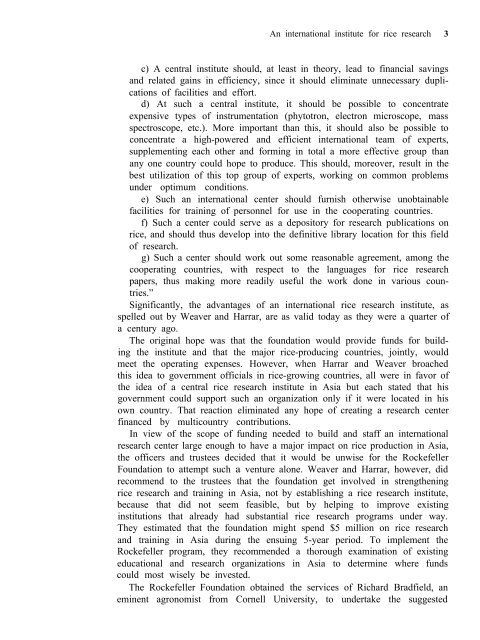An adventure in applied science - IRRI books - International Rice ...
An adventure in applied science - IRRI books - International Rice ...
An adventure in applied science - IRRI books - International Rice ...
- No tags were found...
Create successful ePaper yourself
Turn your PDF publications into a flip-book with our unique Google optimized e-Paper software.
<strong>An</strong> <strong>in</strong>ternational <strong>in</strong>stitute for rice research 3c) A central <strong>in</strong>stitute should, at least <strong>in</strong> theory, lead to f<strong>in</strong>ancial sav<strong>in</strong>gsand related ga<strong>in</strong>s <strong>in</strong> efficiency, s<strong>in</strong>ce it should elim<strong>in</strong>ate unnecessary duplicationsof facilities and effort.d) At such a central <strong>in</strong>stitute, it should be possible to concentrateexpensive types of <strong>in</strong>strumentation (phytotron, electron microscope, massspectroscope, etc.). More important than this, it should also be possible toconcentrate a high-powered and efficient <strong>in</strong>ternational team of experts,supplement<strong>in</strong>g each other and form<strong>in</strong>g <strong>in</strong> total a more effective group thanany one country could hope to produce. This should, moreover, result <strong>in</strong> thebest utilization of this top group of experts, work<strong>in</strong>g on common problemsunder optimum conditions.e) Such an <strong>in</strong>ternational center should furnish otherwise unobta<strong>in</strong>ablefacilities for tra<strong>in</strong><strong>in</strong>g of personnel for use <strong>in</strong> the cooperat<strong>in</strong>g countries.f) Such a center could serve as a depository for research publications onrice, and should thus develop <strong>in</strong>to the def<strong>in</strong>itive library location for this fieldof research.g) Such a center should work out some reasonable agreement, among thecooperat<strong>in</strong>g countries, with respect to the languages for rice researchpapers, thus mak<strong>in</strong>g more readily useful the work done <strong>in</strong> various countries.”Significantly, the advantages of an <strong>in</strong>ternational rice research <strong>in</strong>stitute, asspelled out by Weaver and Harrar, are as valid today as they were a quarter ofa century ago.The orig<strong>in</strong>al hope was that the foundation would provide funds for build<strong>in</strong>gthe <strong>in</strong>stitute and that the major rice-produc<strong>in</strong>g countries, jo<strong>in</strong>tly, wouldmeet the operat<strong>in</strong>g expenses. However, when Harrar and Weaver broachedthis idea to government officials <strong>in</strong> rice-grow<strong>in</strong>g countries, all were <strong>in</strong> favor ofthe idea of a central rice research <strong>in</strong>stitute <strong>in</strong> Asia but each stated that hisgovernment could support such an organization only if it were located <strong>in</strong> hisown country. That reaction elim<strong>in</strong>ated any hope of creat<strong>in</strong>g a research centerf<strong>in</strong>anced by multicountry contributions.In view of the scope of fund<strong>in</strong>g needed to build and staff an <strong>in</strong>ternationalresearch center large enough to have a major impact on rice production <strong>in</strong> Asia,the officers and trustees decided that it would be unwise for the RockefellerFoundation to attempt such a venture alone. Weaver and Harrar, however, didrecommend to the trustees that the foundation get <strong>in</strong>volved <strong>in</strong> strengthen<strong>in</strong>grice research and tra<strong>in</strong><strong>in</strong>g <strong>in</strong> Asia, not by establish<strong>in</strong>g a rice research <strong>in</strong>stitute,because that did not seem feasible, but by help<strong>in</strong>g to improve exist<strong>in</strong>g<strong>in</strong>stitutions that already had substantial rice research programs under way.They estimated that the foundation might spend $5 million on rice researchand tra<strong>in</strong><strong>in</strong>g <strong>in</strong> Asia dur<strong>in</strong>g the ensu<strong>in</strong>g 5-year period. To implement theRockefeller program, they recommended a thorough exam<strong>in</strong>ation of exist<strong>in</strong>geducational and research organizations <strong>in</strong> Asia to determ<strong>in</strong>e where fundscould most wisely be <strong>in</strong>vested.The Rockefeller Foundation obta<strong>in</strong>ed the services of Richard Bradfield, anem<strong>in</strong>ent agronomist from Cornell University, to undertake the suggested

















